Sugar dries food better than sunlight because it actively creates a controlled preservation environment rather than relying on weather conditions. When you add sugar to food, it binds with water molecules through hygroscopic properties, pulling moisture away from microorganisms that cause spoilage. Unlike sun drying, which depends on temperature and humidity, sugar works immediately through osmosis to dehydrate harmful bacteria and mold. You'll get more consistent results with sugar preservation since it maintains food's natural color, texture, and flavor while creating a stable, low-moisture environment. There's much more to discover about this reliable preservation method's scientific process.
The Science Behind Sugar Preservation
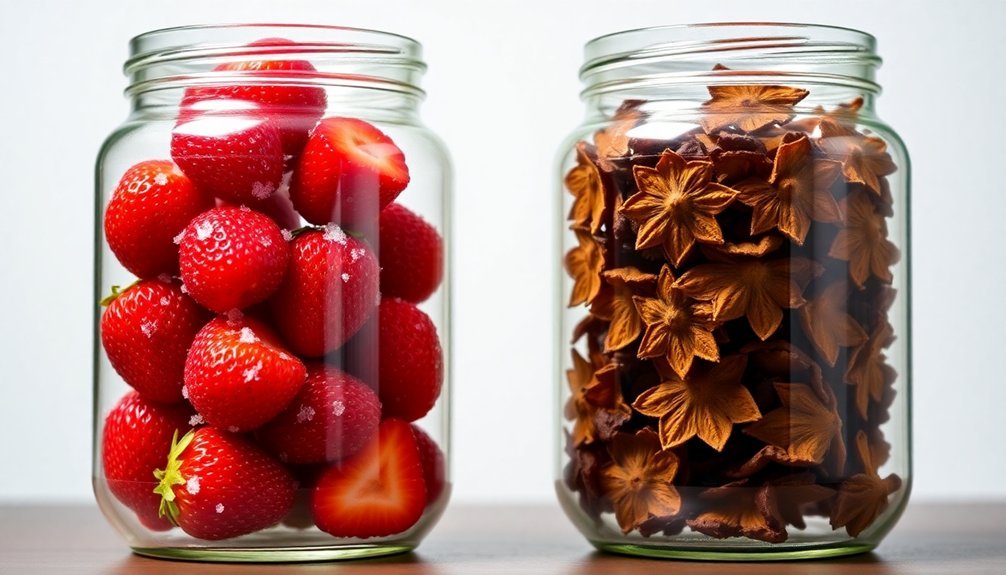
When you're preserving foods with sugar, you're not just preventing spoilage – you're also protecting the food's natural qualities.
Sugar helps maintain color by preventing enzymatic browning, preserves texture, and enhances flavor while ensuring microbial safety. This makes it particularly effective for preserving fruits in jams, jellies, and other sweet preserves. The low water activity created by sugar's hygroscopic properties makes it impossible for harmful bacteria and molds to survive.
Ancient Wisdom Meets Modern Methods
Throughout history, civilizations have ingeniously combined sugar with various preservation methods, creating techniques that still influence modern food storage. You'll find that ancient cultures didn't just rely on sugar alone – they combined it with other preservation methods like drying, heating, and refrigeration to maximize food longevity.
When you look at early modern practices, you'll see how sugar and honey were mixed with butter and other ingredients, not just for preservation but also for perceived health benefits. They'd preserve figs with sugar and consume them with wine, believing in their medicinal properties. In northern climates where sun drying wasn't practical, people heated fruit with sugar to achieve better results. Jams and jellies remain prime examples of this sugar preservation technique.
Today's preservation methods have evolved from these ancient practices, but they still incorporate many traditional principles. You'll notice that modern techniques like pasteurization work alongside sugar preservation, while alternatives such as ascorbic acid prevent fruit browning.
Solar drying has improved upon traditional sun drying by offering better temperature control and ventilation. The combination of these ancient wisdom and modern innovations gives you more effective and reliable food preservation options than ever before.
Sugar Versus Sun Drying
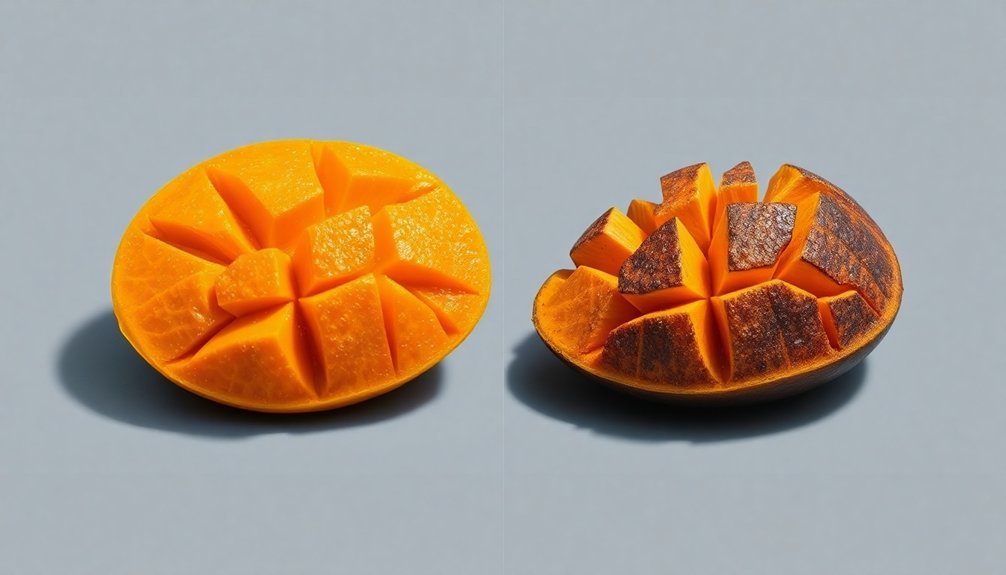
Modern food preservation benefits from understanding how sugar and sun drying work together and compete.
While sun drying relies on weather conditions and can take several days to complete, sugar's natural preservative properties work immediately to prevent microbial growth. You'll find that fruits with high sugar content are particularly well-suited for preservation, as their natural sugars enhance both shelf life and nutritional value retention.
When you're choosing between sun drying and sugar preservation, consider that sun drying requires specific conditions – hot, breezy days with low humidity – that aren't always available. Natural sunlight preservation eliminates the need for artificial energy sources and electricity.
Sugar, however, works consistently regardless of weather conditions. You'll notice this especially with vegetables and meats, which don't dry well in the sun due to their low sugar content, making them more susceptible to spoilage.
While both methods can effectively preserve food, sugar's reliability gives it an edge.
You don't need to worry about protecting your food from insects, birds, or night moisture as you'd with sun drying. Plus, sugar preservation helps maintain the food's natural flavors and keeps the original texture better than traditional sun drying methods.
Understanding Osmosis in Food Storage
You'll find that osmosis naturally seeks balance between two environments, which is why sugar plays such a powerful role in food preservation.
When you add sugar to foods, you're creating an imbalance that forces water molecules to move away from the food and toward the sugar.
This movement of water molecules helps create a more stable environment for long-term food storage, as microorganisms can't thrive without adequate moisture.
Osmosis Creates Food Balance
Balance in food preservation relies heavily on the principle of osmosis, a natural process where water moves across cell membranes from areas of low to high solute concentration. When you add sugar to food, you'll create a hypertonic environment that draws water out of microbial cells, effectively dehydrating them and disrupting their metabolism.
The osmotic pressure you generate through sugar concentration helps maintain food stability by:
- Reducing water activity (aw) below 0.90, making it difficult for microorganisms to thrive and multiply
- Creating a controlled environment where water molecules bind to sugar, becoming unavailable for microbial growth
- Disrupting enzymatic activities within microorganisms, preventing them from breaking down food
- Maintaining ideal moisture levels that preserve food texture and flavor while preventing spoilage
You'll find this balance particularly important in making preserves like jams and jellies, where sugar's osmotic properties work to protect food quality.
The process doesn't just preserve – it transforms your food into a stable product that maintains its nutritional value and sensory characteristics.
Sugar Moves Water Away
Through the remarkable process of osmosis, sugar actively draws water away from food and microorganisms, creating an environment that naturally preserves your ingredients. When you add sugar to food, it establishes a hypertonic environment that forces water molecules to move across semi-permeable membranes, seeking balance between areas of different concentrations.
| Process | Effect | Result |
|---|---|---|
| Osmotic Pressure | Water exits cells | Dehydrated microbes |
| Concentration Change | Reduced water activity | Preserved food |
| Sugar Penetration | Deep moisture removal | Even preservation |
| Membrane Action | Blocked sugar molecules | Consistent drying |
You'll find this process more reliable than sunlight dehydration because sugar penetrates deep into your food, creating uniform preservation throughout. While the sun only dries the surface, sugar's osmotic effect reaches every layer of your ingredients. The sugar molecules are too large to enter microbial cells, but they'll continuously draw water out, effectively stopping harmful organisms from growing. This process doesn't depend on weather conditions, and it'll maintain your food's nutritional value better than sun-drying alone.
Benefits of Sugar Preservation
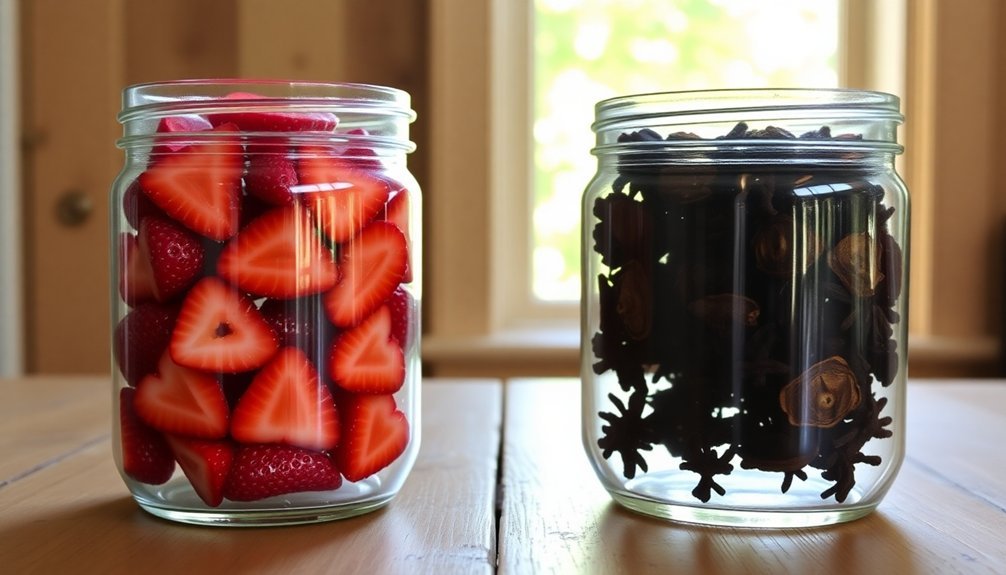
When you're preserving food with sugar, you'll find it provides exceptional control over moisture through its ability to draw water out of ingredients and maintain stable water content.
Your preserved foods will stay protected against spoilage because sugar creates an environment where harmful microorganisms can't thrive.
Sugar's preservative qualities go beyond just controlling moisture, as it also helps maintain the food's original texture, color, and flavor over extended storage periods.
Reliable Moisture Control
Sugar's remarkable moisture-controlling abilities make it one of nature's most effective food preservatives. When you add sugar to foods, it reduces water activity below the vital threshold of 0.85, making it impossible for harmful microorganisms to survive and multiply.
Through its hygroscopic properties, sugar actively draws moisture away from food while creating an environment where bacteria, yeasts, and molds can't thrive.
You'll find sugar's preservation power particularly effective because it competes directly with microorganisms for available water. This competition creates a natural desiccating effect that's essential for long-term food storage and safety.
When combined with other preservation methods, sugar's moisture control becomes even more reliable.
Here are the key ways sugar controls moisture in food:
- Reduces water activity to levels below 0.85, preventing microbial growth
- Absorbs and binds available moisture through hygroscopic properties
- Competes with microorganisms for water, creating an inhospitable environment
- Works synergistically with other preservation methods like drying and refrigeration
This reliable moisture control makes sugar particularly effective in preserving jams, jellies, dried fruits, and confectionery products, ensuring they remain safe and stable for extended periods.
Long-Term Quality Protection
Beyond reliable moisture control, the long-term quality protection offered by sugar preservation stands out as a multi-faceted benefit for food storage. When you preserve foods with sugar, you'll maintain their quality through multiple mechanisms that work together to protect your food's essential characteristics.
You'll notice that sugar-preserved foods retain their vibrant colors and natural appearance because sugar prevents enzymatic browning and protects food pigments from degradation. This preservation method helps you maintain the visual appeal of fruits and vegetables long after they've been processed.
Additionally, you're ensuring microbial safety by creating an environment where harmful bacteria, yeasts, and molds can't thrive, markedly reducing the risk of foodborne illnesses.
The texture and taste benefits are equally impressive. You'll find that sugar helps form gels in products like jams and jellies while enhancing the overall mouthfeel of preserved foods.
It's not just about sweetness – sugar preservation maintains the natural flavors of your foods while extending their shelf life considerably. This means you can store your preserved foods for extended periods without requiring constant refrigeration, making it a practical and effective long-term storage solution.
Selecting Foods for Sugar Drying
For successful sugar drying, selecting the right foods makes all the difference in achieving excellent results. You'll want to focus on foods that contain natural fiber and proteins, as these components help create an ideal environment for the sugar-drying process.
When choosing ingredients, consider foods with healthy fats and antioxidants, as they'll maintain their nutritional value better during the preservation process.
- Lean proteins like chicken and fish work exceptionally well with sugar drying, as their protein content helps create a protective barrier that locks in moisture while allowing proper preservation.
- Non-starchy vegetables, particularly bell peppers and cucumbers, respond effectively to sugar drying due to their low moisture content and firm texture.
- Fruits with moderate water content are excellent candidates, though you'll need to control their natural sugar levels during the drying process.
- Legumes and beans can be sugar-dried effectively after proper pre-cooking, maintaining their nutritional benefits and extending their shelf life.
When selecting foods for sugar drying, you'll achieve the best results by choosing items that aren't overly watery or fatty, as these characteristics can interfere with the preservation process and lead to inconsistent results.
Step by Step Sugar Preservation

Once you've selected the right foods for sugar drying, mastering the preservation process involves following specific steps that guarantee safety and ideal results.
You'll need to start by layering your prepared fruit with sugar in a clean, refrigerator-safe container, alternating between the two until you've used all your ingredients.
Let your fruit macerate in the refrigerator for 24 hours to three days, during which time the sugar will draw out the fruit's natural moisture.
After maceration, you'll separate the fruit from the resulting syrup and heat the syrup alone to 230˚F in a heavy-bottomed pot, skimming off any foam that forms during the 25-minute cooking process.
Once your syrup reaches the target temperature, you'll add your macerated fruit and continue cooking until the fruit becomes translucent and the syrup thickens.
You'll know it's ready when the bubbling sound changes to a distinctive splatting noise. Test the consistency by placing a spoonful in the freezer.
When you're satisfied with the texture, transfer your preserves to sterilized containers. For long-term storage, process the jars in a water bath for 10 minutes, or store them in the refrigerator for shorter periods.
Common Sugar Preservation Mistakes
Despite its straightforward nature, sugar preservation can go wrong in several important ways. When you're making jams and jellies, the balance between sugar and juice must be precise – too much sugar leads to crystallization, while too little results in poor preservation.
You'll also need to master the cooking process, as both overcooking and undercooking can ruin your preserves.
- Use the correct ratio of sugar to juice, making certain you don't exceed or fall short of the recommended amounts.
- Cook rapidly to reach the jellying point without prolonged heating that could cause crystallization.
- Always use new, properly sterilized two-piece lids and avoid outdated paraffin sealing methods.
- Process jars in a boiling water bath for the recommended time to guarantee proper sterilization.
Proper storage and handling are equally important. If you're storing your preserves, make sure to avoid warm, humid environments that can cause weeping.
Don't forget to remove air bubbles before sealing, and resist the urge to overtighten lids.
Following approved recipes is essential, as incorrect measurements or techniques can lead to unsafe pH levels and potential foodborne illness.
Long Term Storage Solutions
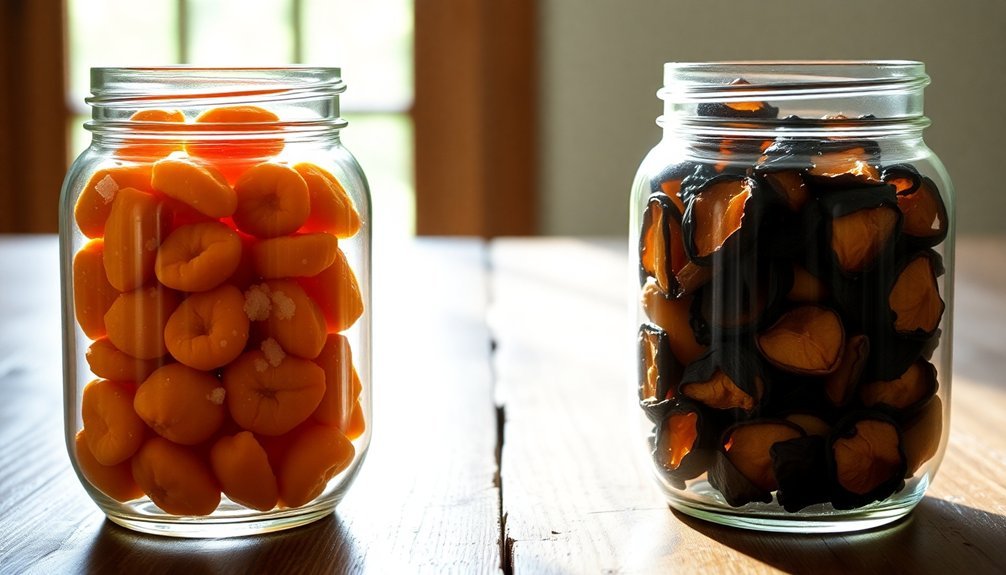
When storing sugar for extended periods, choosing the right container and environment makes all the difference. You'll want to select opaque, airtight containers that prevent moisture and odor absorption. Food-grade plastic buckets, Mylar bags, and glass canning jars work perfectly for dry sugar, while #10 cans are better suited for liquid syrups and honey.
Your storage location should be cool and dry, away from strong odors and extreme temperatures. Don't store sugar in the refrigerator, as this can introduce unwanted moisture. Heat can darken your sugar and alter its flavor, while freezing temperatures promote crystallization.
If you're storing honey, you'll need lined, food-grade metal containers to prevent rust.
For the longest shelf life, stick with commercial, refined granulated sugar. While raw sugars and honey are nutritious, they don't store as well long-term. Brown sugar isn't ideal for extended storage due to its natural moisture content.
Remember that even though sugars have an indefinite shelf life, their quality may decrease over time. You can minimize this by maintaining proper storage conditions and using containers that haven't previously held non-food items.
Frequently Asked Questions
Can Sugar-Preserved Foods Be Safely Consumed by Diabetic Individuals?
You shouldn't regularly consume sugar-preserved foods if you're diabetic, as they contain high sugar levels that'll spike your blood glucose. It's better to choose alternative preservation methods or consult your healthcare provider first.
Does the Type of Sugar Used Affect the Color of Preserved Foods?
You'll find that different types of sugar (like sucrose, sucralose, or Stevia) don't greatly impact the color of preserved foods. What matters most is sugar's ability to reduce water activity, regardless of type.
How Do Artificial Sweeteners Compare to Natural Sugar for Food Preservation?
You can't preserve food with artificial sweeteners since they lack sugar's moisture-binding properties. Unlike natural sugar, they won't draw water out of food or create the antimicrobial environment needed for preservation.
Can Mold Develop on Sugar-Preserved Foods if Stored in Humid Conditions?
Yes, your sugar-preserved foods can develop mold in humid conditions. While sugar's normally a great preservative, it'll absorb moisture from humid air, potentially creating enough dampness for mold to grow if not stored properly.
What Happens if You Mix Salt and Sugar Preservation Methods?
When you combine salt and sugar preservation methods, you'll get enhanced food protection since they work together to reduce water activity even more effectively, creating a stronger barrier against microbial growth and spoilage.
In Summary
You've now learned why sugar preservation outperforms sun drying for food storage. With sugar's osmotic properties, you'll achieve better results than relying on sunlight alone. Remember to select the right foods, follow proper techniques, and avoid common mistakes. When you're ready to start preserving, you'll find that sugar drying offers a reliable, time-tested method that keeps your food fresh and flavorful for months to come.

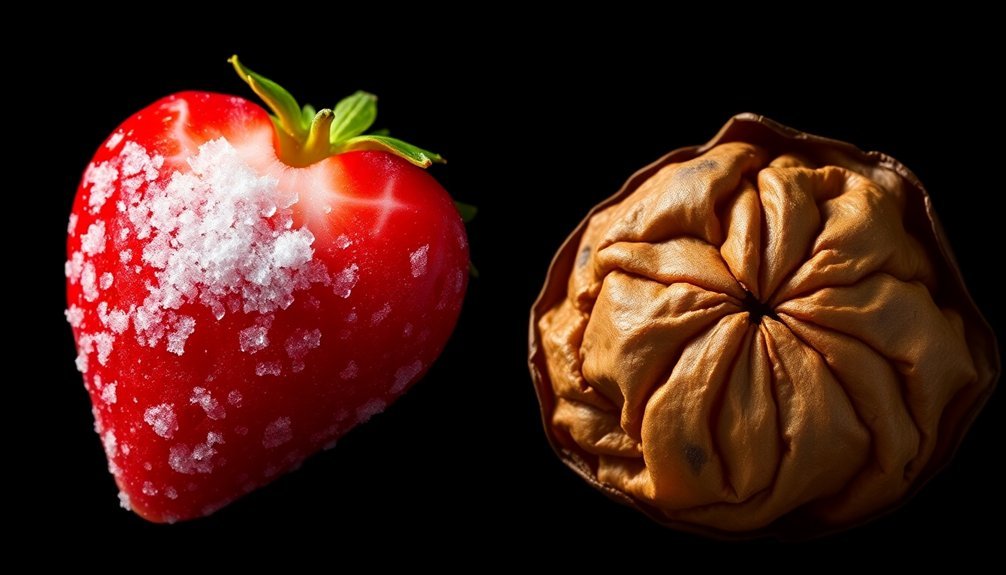



Leave a Reply